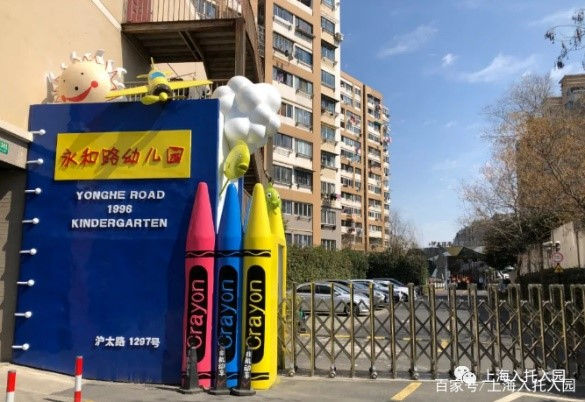
In December of 2023, we were warmly invited to visit Shanghai for a cross institutional marketing visit. In the early stages of developing the trip, we were asked if there were any extra-curricular activities we would care to undertake whilst in China. Chenhua, an academic employed by the Shanghai Xianjing College (SXC) would undertake dual responsibilities of being our gracious host and local guide. Both Matt and I have a professional background in Early Years, and when Chenhua suggested she was able to organise a professional visit, to Yonghe Road Kindergarten in Shanghai, as part of these extra-curricular activities, we jumped at the chance.
Pre-school care and education in China is most concentrated in urban and developed areas with two types of early childhood education offered at different ages. Nursery education is available for children from birth to three years old and focusses on providing care, early stimulation and supportive environments for infants and toddlers. Kindergartens provide education and care for children between three and six years old, serves as a preparatory stage for education and focusses on fostering social, emotional, physical and cognitive development.
Due to the sheer scale of China (9.597 km²) and its mix of urban and rural landscapes, early childhood education varies in terms of structure and teaching methods. Some commonalities are evident across regions with the national government offering early development and learning guidelines but there is sufficient flexibility in the system to allow local governments and settings to develop curricula based on local need. Kindergarten settings are divided into state-maintained settings and private organisations. Yonghe Road Kindergarten is a local government-maintained setting in the Yangpu district of Shanghai. (The organisation and funding of the setting is not dissimilar to our maintained nursery schools in the UK). This blog is a reflection on our visit to the Kindergarten, examines we learned from this visit and how this has supported us within a wider context of looking through a global lens at early education.
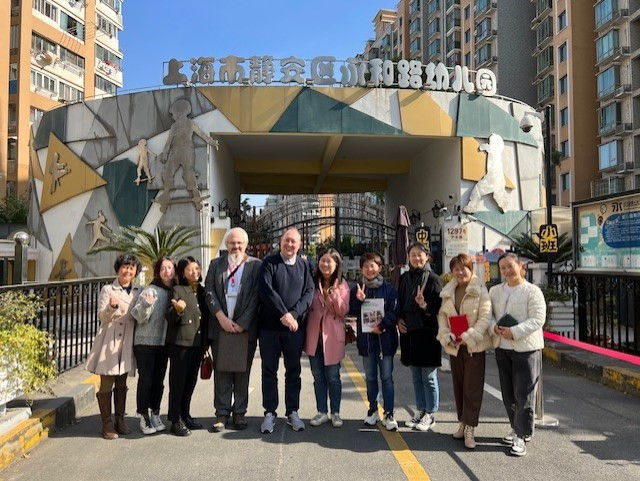
The visit was an interesting one. To be welcomed by such a large staff team and children demonstrated the sheer positiveness of engagement from our early years colleagues. Many of them had been educated in the UK at either undergraduate or post-graduate level which in turn, sees them as graduates within practice…a fact which is highly regarded in Kindergartens within China. Yonghe Road Kindergarten catered for children between the ages of three- and six-years old and we were pleased to hear that the nursery settings children would attend pre-Kindergarten were often referred to as ‘baby houses.’
Prior to our visit to the Kindergarten we had the pleasure of experiencing the early childhood department of SXC and saw a mock ‘baby house’ that was used for practical simulations with undergraduate students. We were both thrilled to see this important life stage celebrated with such enthusiasm. There is so much we would like to communicate about this visit but will focus specifically on the Kindergarten aspect of our time in China. We enjoyed every minute of our visit to the Kindergarten and here is why.
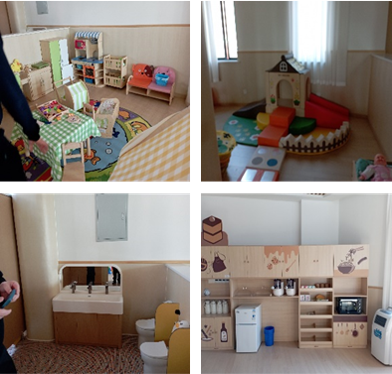
Curriculum: The curriculum in Chinese kindergartens focuses on a mix of academic and social development. While there is some emphasis on early literacy and numeracy skills, the overall approach is often play-based, with an emphasis on fostering creativity, curiosity, and social skills drawing some comparisons with the English Early Years Foundation Stage Statutory Framework.
Whilst the connection to the work of Fredrich Froebel was evident in the Kindergarten approach here in Shanghai, so to was that of Loris Malaguzzi and the Reggio Emilia approach. The arts shone through both in terms of our visit to the Kindergarten and at SXC. Both locations had prominent performance spaces and teachers were actively encouraged to promote art, singing, dancing and dramatic re-enactments. Within the Kindergarten there were a variety of dedicated art spaces (both indoors and outside) and the children took a genuine pride in what they had been working on.
A visiting art teacher attends the Kindergarten once a week and engages the children in a range of crafts ranging from collage production, painting, photography, traditional Chinese calligraphy and performing arts. This is not dissimilar in role to that of the Atelierista in Reggio settings. This term, the children were concentrating on the theme of autumn and we had the great pleasure of observing their work which adorned the walls of dedicated art rooms like masterpieces hanging in the Louvre.
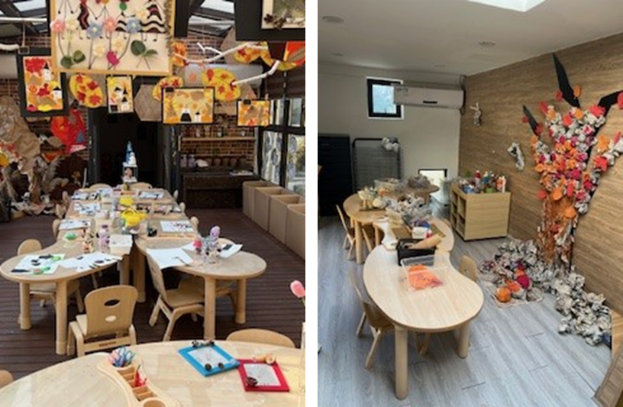
The joy shining from the children, the calmness it provided and the inclusion of all was something to behold. Creativity was also threaded through to child-initiated play. There were certain zones where this happened similar to the atelier in Reggio settings, but it was free flow from the point that no part of the Kindergarten was off limits and the arts could be practiced anywhere. Within SXC, trainee Kindergarten teachers undertake mandatory piano lessons, and all Kindergarten teachers are expected to include singing as part of the curriculum offer each day.
Activities and children’s play: Kindergarten activities often include a mix of indoor and outdoor play, arts and crafts, music, and movement. There may also be activities designed to enhance motor skills, cognitive development, and language acquisition. We were in awe of how the space indoors and outdoors was being utilised. Stairs would turn into slides, the climbing ropes and tunnels fed into the outside from indoor starting points. Physical development was a positive focal point within this kindergarten, allowing children opportunities to move around the setting in many ways.
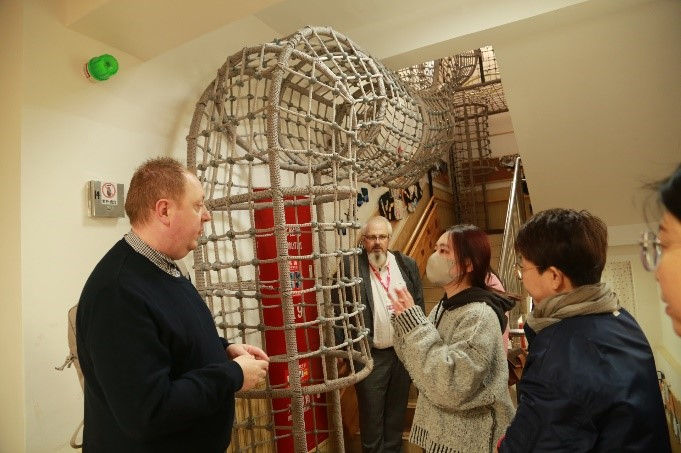
On the day of our visit, we had the opportunity to witness another commonality between early childhood practice in the UK and China. The children were engaged in a ‘people who help us’ activity day and this included the entire Kindergarten (approximately 40 staff and 200 children) practising a fire drill and being greeted in the outdoor learning area by local fire officers. The excitement and energy from the children was palpable and they thoroughly enjoyed engaging with the fire engine and safety equipment which was practically demonstrated to them.

The Kindergarten evidently had a daily routine that included time for play, group activities, arts, learning sessions, mealtimes and time for rest. Younger children have access to a dedicated, quiet bedroom space, with fully fitted infant bunk beds and blackout curtains to aid their slumber.
Staff at Yonghe Road Kindergarten were keen to impress the need to find a balance between child- initiated learning and more structured activities that would prepare children for elementary school. The staff were keen to impress that children in Kindergarten were grouped into three categories. ‘Juniors’ were the youngest children (three-year-olds) and would have much greater opportunities for free form play, four year olds are classed as ‘middle’ and would have fewer opportunities for child initiated learning and ‘seniors’ (five year olds) would be engaged in more structured learning in preparation for formal schooling. It is important to note that this formal schooling does not begin until a child is 6 years old with Kindergarten in China seen as essential foundations for future learning.
The Chinese Government offer national dietary guidelines for preschool children and the Kindergarten staff were keen to share their approach to implementing these guidelines with us. The setting employs a full time staff headed by a chef/food nutritionist who prepares healthy, balanced meals for the children (and staff) each day. We were most fortunate to have been invited to dine with the leadership team at the Kindergarten and enjoyed a hot meal of fish, meat, vegetables, rice and exotic fruits.
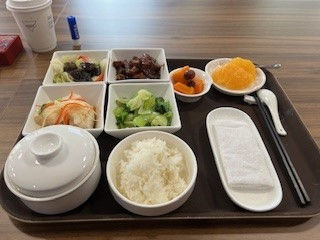
It is important to be mindful that experiences can vary widely in terms of early childhood experiences in a country as vast as China. Increasingly, diversification of its populous continues to have an impact on educational approaches particularly in urban areas, international and private schools. This was some of our thoughts and thinking visiting the kindergarten. We did however walk away seeing the investment that has gone into early education, funding and workforce training within this local government kindergarten.
We will sign off with this. Take two grown men with early years qualification and years of practice experience, place them in a Kindergarten (anywhere on the globe) and they will play. We would like to thank our gracious hosts for such a wonderful opportunity to visit their setting and look forward to bringing our learning from this experience alive for our students when considering international perspectives of early childhood practice.

By Dr Aaron Bradbury and Matthew Northall

Comments